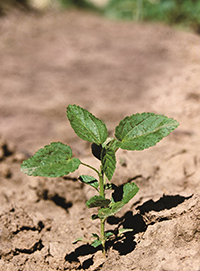 Prickly sida is a broadleaf summer annual weed. The plant is native to the eastern and southern United States. It can be found in Midwest states like Illinois, Indiana and Missouri.
Prickly sida is a broadleaf summer annual weed. The plant is native to the eastern and southern United States. It can be found in Midwest states like Illinois, Indiana and Missouri.
- Common names: Prickly sida, teaweed, Indiana mallow
- Scientific name: Sida spinosa
- Cotyledons: Heart-shaped, covered in small hairs
- Leaf shape: Small ¾ to 2 inches long, oval-shaped with toothed edges, positioned on alternate stems
- Reproduction: Seeds
- Flowers: Pale yellow with five petals
Fast facts1
- Prickly sida is a summer annual broadleaf.
- IWillTakeAction.com and WeedScience.org list prickly sida as resistant to ALS-inhibiting herbicides in Georgia.
- According to IWillTakeAction.com, prickly sida with resistance to imazaquin (a Group 2 ALS-inhibiting herbicide) was reported in Georgia in 1993.
- Prickly sida is a member of the mallow family, related to velvetleaf and cotton.
- Prickly sida can be found in cornfields. However, it is especially troublesome in soybean fields, causing up to 10% of yield loss when it emerges at a density of 20 plants per square foot of field.
- A single plant can grow up to 3 feet tall and produce 1,000 seeds.
- The weed germinates faster in hot weather.
Control tips1
Corteva Agriscience offers the following weed control solutions. Find the solution that’s right for you at Corteva.us:
Corn herbicides:
Cinch® ATZ herbicide
Durango® DMA® herbicide
Elevore® herbicide
Enlist Duo® herbicide, as part of the Enlist™ weed control system
Enlist One® herbicide, as part of the Enlist™ weed control system
FulTime® NXT herbicide
Keystone® LA NXT herbicide
Keystone® NXT herbicide
Realm® Q herbicide
Resicore® herbicide
SureStart® II herbicide
Soybean herbicides:
Durango® DMA® herbicide
Elevore® herbicide
Enlist Duo® herbicide, as part of the Enlist™ weed control system
Enlist One® herbicide, as part of the Enlist™ weed control system
EverpreX® herbicide
Sonic® herbicide
Surveil® herbicide
Envive® herbicide
Trivence® herbicide
1United Soybean Board. 2020. Take Action: Prickly sida (teaweed). https://iwilltakeaction.com/weed/prickly-sida-teaweed
™ ® Cinch ATZ, FulTime NXT, Keystone LA NXT and Keystone NXT are Restricted Use Pesticides. Cinch ATZ, Durango DMA, Elevore, FulTime NXT, Keystone LA NXT, Realm Q, Resicore, Sonic, SureStart II, Surveil and Trivence are not registered for sale or use in all states. Keystone NXT is not available for sale, distribution or use in all states. FulTime NXT, Keystone LA NXT, Keystone NXT, Resicore and SureStart II are not available for sale, distribution or use in Nassau and Suffolk counties in the state of New York. Contact your state pesticide regulatory agency to determine if a product is registered for sale or use in your state. Enlist Duo and Enlist One herbicides are not registered for sale or use in all states or counties. Contact your state pesticide regulatory agency to determine if a product is registered for sale or use in your area. Enlist Duo and Enlist One herbicides are the only 2,4-D products authorized for use with Enlist™ crops. Consult Enlist herbicide labels for weed species controlled. Always read and follow label directions.
Recent Articles
- Corteva Agriscience Launches Enversa™ Herbicide
- Field Facts: White Mold
- Managing Through Drought: A Whole-acre Approach
- Keys to Postemergence Corn Weed Control
- Tennessee Retailer Sees Success With New Kyro™ Herbicide
- Get More From Your Enlist One® + Liberty® Tank Mix
- Sustaining Superior Weed Control Technology